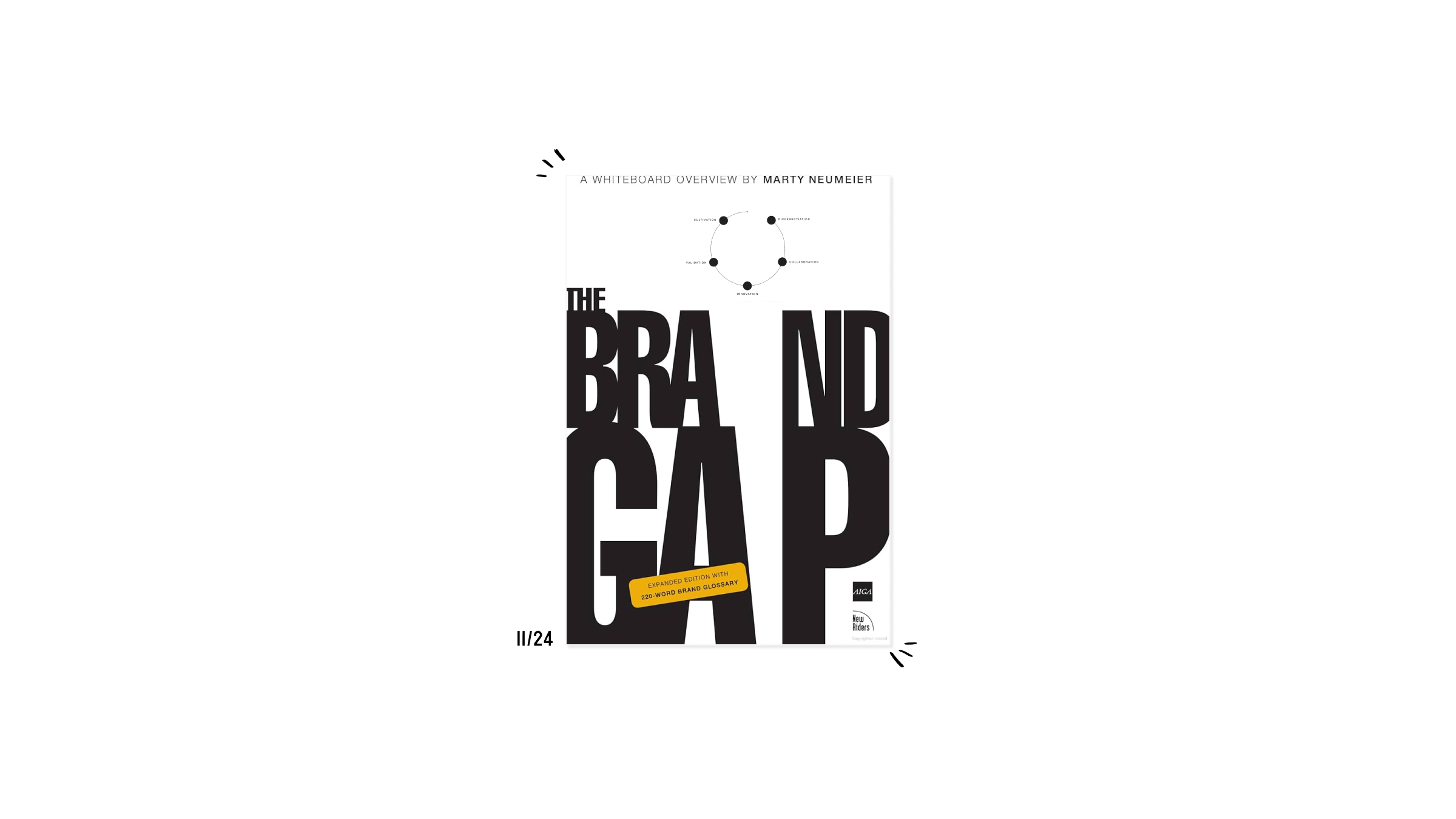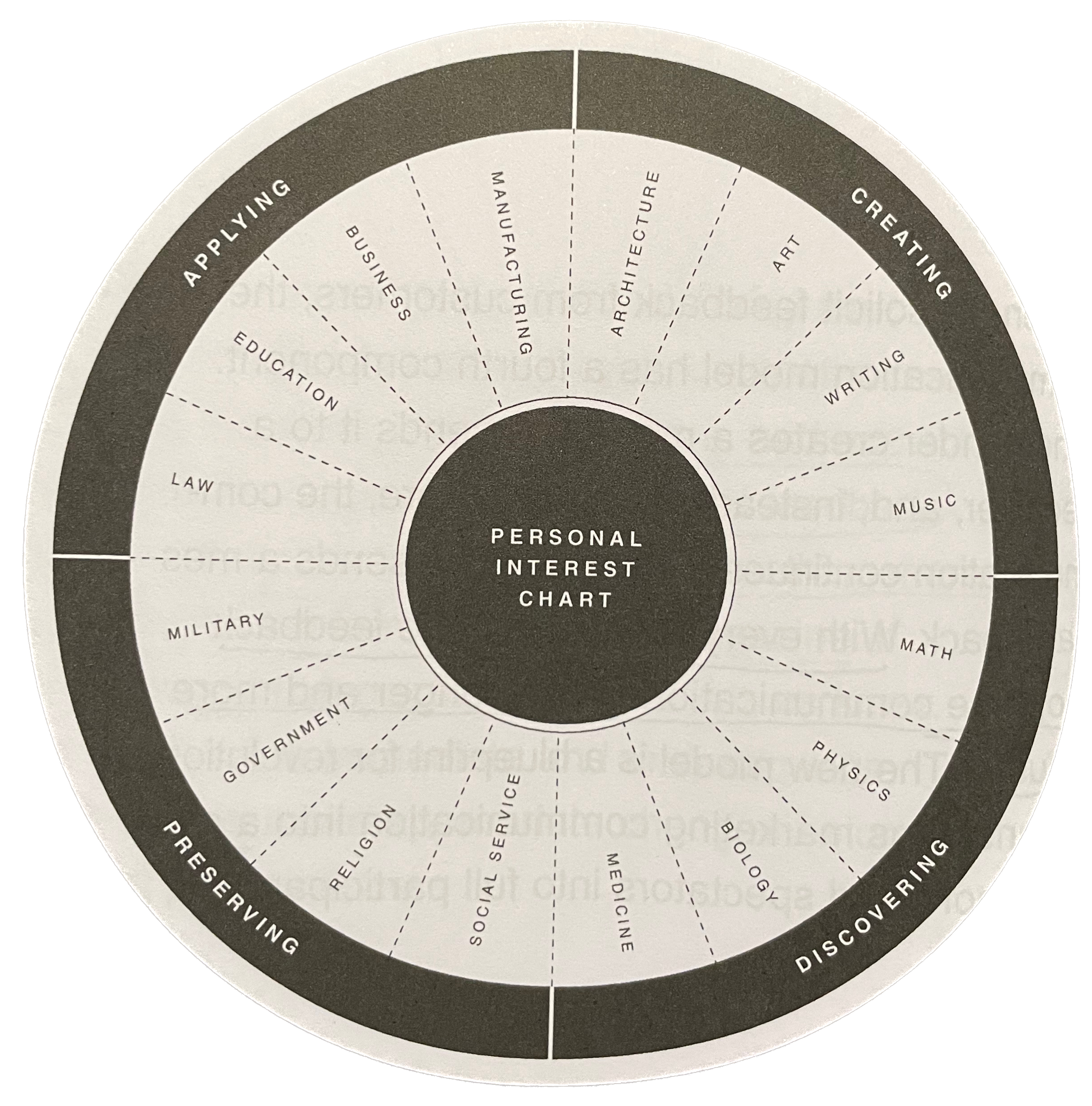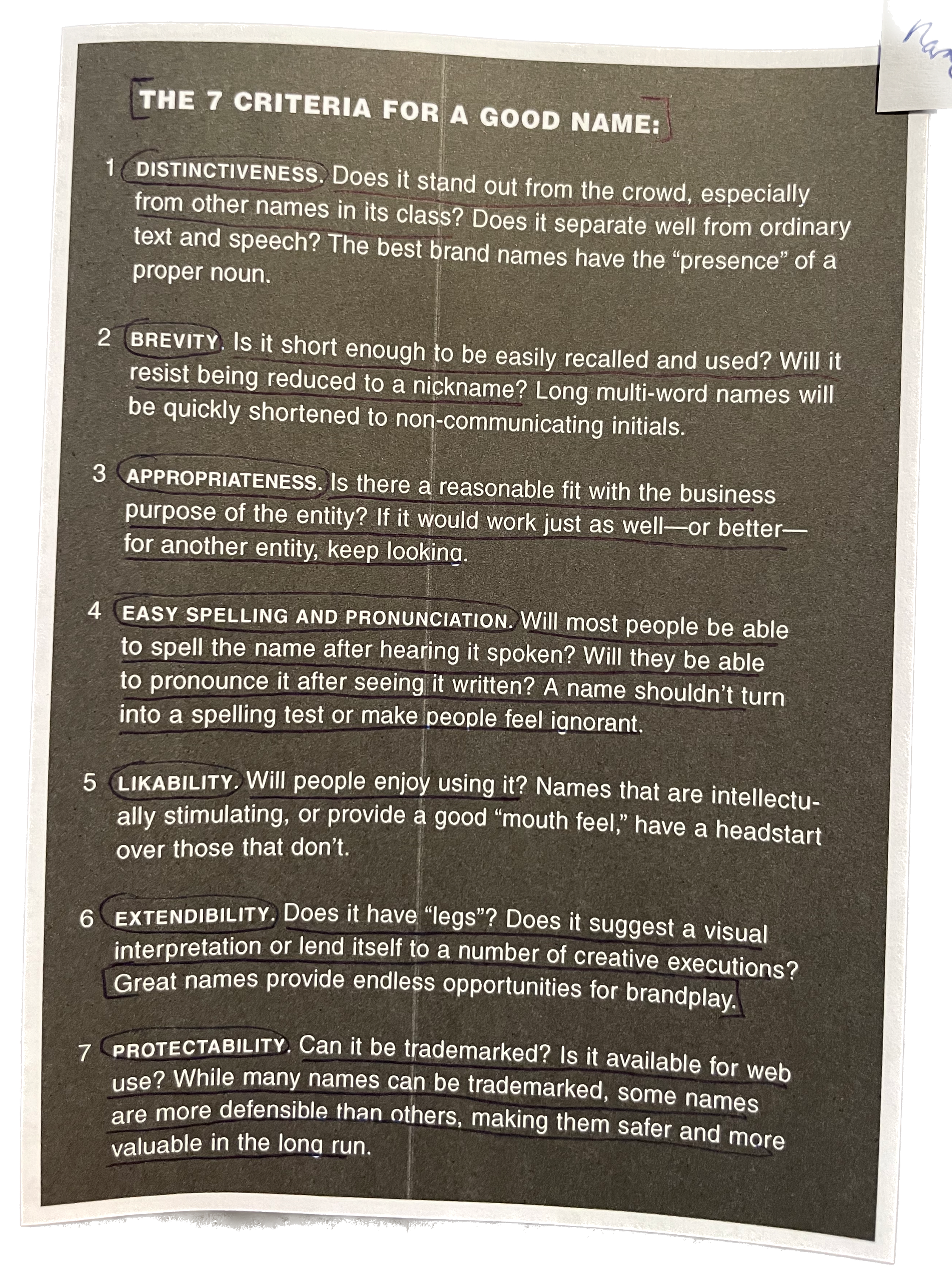Book Takeaways: The Brand Gap by Marty Neumeier
June 24, 2024 • Books • Takeaways ⌇ Connect ↗

No matter how short this book(let) might be, it’s packed to the brim with value and perspectives that will change the way you view branding forever — at least it did for me. Marty Neumeier wrote this book in 2000, and 24 years later it no joke just got even more relevant. Yes, some brands and concepts like the internet are much more advanced, but it is the simplicity he is able to convey complex psychological information from a time, where noise was much less prevalent that just shows he is one of the greatest marketing legends of our time. I can not recommend this book enough for any creative or brand enthusiast. It’s quickly become a base recommendation on my bookshelf, so I can also see myself revisiting these takeaways often over the next years. That said, all ideas in this article are either my own interpretation or direct quotes from Marty Neumeier himself.
But without further ado, let’s dive into my top ideas from The Brand Gap.
Overarching themes
- Logo (greek for word) = Logotype = A symbol of the brand, not the brand itself.
- Branding is simply put: the act of amplifying the contrast that makes you and your product uniquely positioned. Marty Neumeiers rule of thumb is simple: keep it pure, keep it different.
- A brand is not what YOU say it is, it’s what THEY say it is. A brand is a gut feeling that resembles the degree of trust an individual feels towards your product. These are mostly symbolic to answer what people in which tribe like to associate themselves with the product at that price point. Features and benefits don’t influence that much.
- A charismatic brand is any product, service or company for which people believe there is no substitute. These type of brands have 1. A clear competitive stance, 2. A sense of rectitude & 3. A dedication to aesthetics.
- Strategy (left-brain: analytical, linear, concrete, numerical, verbal people) and creativity (right-brain: intuitive, emotional, spatial, visual, physical people) need to be moved closer together to achieve great branding.
- “Aesthetics in branding is the language of feeling and in a society that’s information-rich and time-poor, people value feeling more than information.”
- Marketing has evolved from “what it has” (1900…) → “what it does” (1925…) → “what you’ll feel” (1950…) → “who you are” (2000…). Hence, the UBS (unique buying state) of consumer, AKA their personal identity should be a top priority in 21st century branding.
- Great brand design identifies, informs, entertains, persuades and differentiates itself.
- Clarity = reduction: “the ability to subtract features is the rare gift of the true communicator”.
- The Brand Gap is closed when you master five disciplines: [1] Differentiate → [2] Collaborate → [3] Innovate → [4] Validate → [5] Cultivate — its a virtuous cycle that works because it’s an infinite game, which is the only type of game worth playing, spiralling every brands value even higher, with each round around the circle.
Key ideas & takeaways
[01] Differentiate
- According to Greg Galle, every great brand must be able to answer three questions (almost like the golden circle): 1. Who are you?, 2. What do you do? & 3. Why does it matter?
- As humans, we get data for the world we live in via our senses. Sight being the one we rely on most every day, with our visual system being hardwired to notice visual difference from large to granular. In short: our brain is looking for contrast like near vs. far, old vs. New, light vs. heavy, peaceful vs. aggressive, simple vs. complex, easy vs. difficult. The masterful use of contrast, defines what is aesthetically pleasing.
- Similarly to our brains working in contrast, we need divisions and barriers to feel understood. The trend of globalism therefore leads to the “who you are” marketing trend because people are erecting artificial divisions by means of amplifying their personal identity differences. These resulting intimate worlds create new tribes to belong and feel understood. Braiding’s job is to build or join a tribe.
- Buying a differentiated product in the 21st century is like being part of a clan, each ruling a niche need, activity, mood or situation in our lives. And we get to choose who we give that privilege to, whilst being able to switch at any time.
- A narrowly focused brand know what it is, why it’s different and why people want it: “being number one in a small category is often better than being number three in a large one”.
- “Competition forces specialisation”. So don’t want to be forced to survive. Focus and differentiate early.
- David Aaker of growing a brand to managing a timber reserve: “you plant tree for future profits and you harvest old trees for profit today”. The elegance in brand growth is knowing which is which, to avoid defocusing (e.g. line extensions can often be more dangerous than giving).
[02] Collaborate
- “It takes a village to grow a brand.” — Brands don’t evolve without the interaction of thousands of people.
- Three basic models for brand collaboration have emerged: 1. One-stop shop outsourcing (trade-off: various disciplines are not best in class), 2. Brand agency outsourcing (trade-off: stewardship is heavily reliant on the external partner) & 3. Integrating a marketing team (trade-off: talent needs to be understood and retained from within).
- Finding ways to create networked talent pools is the future of brand collaboration as quality and speed are the result of custom solutions that are tailored to the minds being put together for a specific project.
- To keep a fast pace, brands are starting to adopt a lean startup mindset, where “the script (the creative brief) is the prototype for the story and the storyboard (mockup/draft) is the prototype for production”.
- A brand is a prospects gut feeling about the product, service of company. Which makes prototype the fastest way to prioritise the strongest gut feeling response through many versions until a production-worthy version is achieved.
- Brand collaboration is all about creating magical output from synergetic minds.
[03] Innovate
- Good strategy x Poor execution = Failure because execution is the magic to ignite passion in teams and customers, not logic.
- Innovation is the competitive advantage that delivers better design and better business. Creativity in the right brain is then the key to make it happen, not analysis in the left brain.
- The right brain creatives describe how the world could be be, whilst left brain analysers describe how the world is.
- Creativity requires non-mimic leadership to achieve innovation. “You can’t be a leader by following”. So when everybody zigs, zag.
- MAYA = the Most Advanced Yet Acceptable solution, which is the desired creative thinking innovation needs to come into place. MAYA does not require you to reinvent the wheel, just to have fresh eyes.
- Prospects want more than logic, they want creativity.
- How to stifle innovation? Fear being stupid — it’s an inevitable result of daring to be different.
- Innovation therefore usually comes from the outside because risk is outsourced and it takes people willing to “be the nail that sticks up” rather than fit in to accommodate their fear of being stupid.
- What is a brand icon? A name or visual symbol to communicate a market position.
- What is an earcon? An auditory counterpart of a brand icon. Also called sonic branding.
- What is a brand avatar? An icon that can move or morph as a brands alter ego to become the symbolic actor in a containing brand story.
- More than half of the brain is visually driven. Hence trademarks should not only be strongly visual, but can also incorporate sensical elements like smell, touch, taste or hearing.
- Packaging = branding. “Branding is simply a convenient package for a business idea”. It’s the last opportunity to make or breaks the final sale and builds the foundation for customer loyalty.
- Branding moment: when a prospect is focused on the differences between brands with the right brain taking over the decision-making process, leaving the left brain (and all its past advertising) on the sidelines.
- The golden rule for brand innovation: bring emotion, not logic into branding.
- Packaging principles: clarity, emotion & natural reading sequence. These apply to every brand design.
- How do your prospects process messages? Prospects follow a natural reading sequence that increases not only resonance, but also builds a sympathetic bond with your brand:
- Notice all the visual elements of a brand.
- Asks themselves: “What is it?” highlighting brand name & category.
- Asks themselves: “Why “should I care?”, which is best answered with a “why-to-buy” message.
- Seek more information to support the stated “why-to-buy” message.
- Make a decision by consulting features, price, compatibilities, guarantees, awards etc.:.
- “Advertising pioneer David Ogilvy often claimed that by changing a single word in a headline one could increase effectiveness of an advertisement up to ten times”. Marty Neumeier has proven great packaging that connecting product features to customer emotions resulted in a 3x bump in sales (at least).
- Avoid these 3x things to achieve a great landing page: 1. Technophobia (the fear of new technology), 2. Turfismo (cross-department politics that dilute the core positioning, & 3. Featuritis (or feature creep is the desire to always add more).
- Brand innovation = positive user experiences. The magic lies in forging the intuition to know which will be most positive before actually doing it.
[04] Validate
- Communication happens in a 3-step dialogue: Sender (Brand) → Message (Medium) → Receiver (Prospect). And then flips the script from the Receiver POV. This is the feedback loop to clarify your positioning.
- There are two main personality types: 1. Fact-reliant individuals (hard information driven), & 2. Feeling-reliant individuals (soft information driven). The below chart shows the creatives (right brain) & analysers (left brain).

- How do you find out what message resonates? Test & iterate it until it works by turning wild guesses → educated guesses → validated facts. Testing battles the fear of being stupid. The first step to combat that fear is doing research. This what a pre.page can support you with.
- Do focus groups work? The work for as the starting point for quantitative research, but are to be avoided for qualitative decisions (here 1:1 interviews work best). This is due to the Hawthorne effect, which marks the tendency for people to act differently, when they know others are watching. Not matter what you decide to go with, practice the art of observing to learn asynchronously.
- More research ≠ More initiatives. The best studies are quick because they focus on a single problem at a time.
- Swap Test = exchange the icon or the visual element with another competing brand or another brand in whole other industry — does it still fit? Great brand icons fit like a tailored suit.
- Concept Test = create the smallest version of your idea to gather feedback from your target audience to find out how to 1. Get the right idea and 2. Getting the idea right. At least 10 complete strangers validate the Concept Test by answering specific questions: a persons answer to “why” often lays the foundational seed for the next question — “if you can live with a little uncertainty, an inexpensive concept test will often give you, ample information to turn logic into magic.”
- A validated brand scores high in 5 areas of communication:
- Distinctiveness → the quality of brand expression to stand out from the competing messages.
- Relevance → a brand expression’s appropriateness for its goals.
- Memorability → the quality in the brand expression allowing prospects to recall the brand when they need to.
- Extendibility → how adaptable a brand expression is across all types of media & messaging types.
- Depth → ability of a brand expression to reach prospects on varying levels of understanding.
[05] Cultivate
- As Guy Kawasaki once said: “don’t worry, be crappy” — let the brand live, breathe and make mistakes just like humans. Inconsistencies are therefore not a dealbreaker, unless they go against a brands defining attributes.
- Brands striving for perfection, without depth and humanity lead to suspicion and alienation amongst prospects.
- “A living brand is a collaborative performance, with every employee being an actor in the script”.
- Brand experience <> Prospect expectations = Loyalty boost
- To create loyal customers, always answer this question for your prospects with yes: “does the companies behaviour match the brands image?” The more aligned you are, the more loyal your customers.
- Brand knowledge should not be a contained or siloed craft, but rather a widely shared knowledgeable that can be seen as a brandometer: a way to align employee actions with the goals of a brand. “No decision should be made without asking: will this help or hurt the brand?”
- “The more a brand becomes distributed, the more it requires strong, centralised management.” Intro the CBO (the Chief Brand Officer), who bridges the ability to strategise and inspire creativity in a company. CBO therefore bridge the right (customer experience) and left brain (business strategy) counterparts of a company.
[+] Naming
- A great name is the most convenient way for customers to identify, remember, discuss and and is the winning difference when compare brands.
- “The wrong name can cost millions, even billions in workarounds and lost income over the lifetime of the brand.”
- As George Bernhard Shaw once said: “take care to get born well.”
- Onomatopoeia is a strong literary device that relates the formation of a word from a sound associated with what is named.
- High imagery (Anglo-Saxon words or names) > Low-imagery (Greek and Latin root words). Producing vivid mental picture that aid recall (like Apple or Betty Crocker) is how you will get your brand to be remembered.
- Visual treatments to go hand in hand with that name are a homerun for most brands.
- As David Ogilvy once said: changing a single word could increase effectiveness of advertising up to 10x — that one word could be your brand name.
- “Make sure the name of your brand is distinctive, brief, appropriate, easy to spell, easy to pronounce, likeable, extendible, and protectable.”
- These are the 7 criteria for a good name:

Favorite quotes
“A brand is not a logo. A brand is not a corporate identity system. It’s a person’s gut feeling about a product, service, or company. Because it depends on others for its existence, it must become a guarantee of trustworthy behaviour. Good branding makes business integral to society and creates opportunity for everyone, from the chief executive to the most distant customer.” — Marty Neumeier
“Modern society is information-rich and time-poor. The value of your brand grows in direct proportion to how quickly and easily customers can say yes to your offering.” — Marty Neumeier
“Brands are the little gods of modern life, each ruling a different need, activity, mood, or situation. Yet you’re in control. If your latest god falls from Olympus, you can switch to another one.” — Marty Neumeier
“Some of the most promising ideas have died quick and painful deaths, not because people didn’t WANT them, but because the products didn’t make sense at the point of contact” — Marty Neumeier
“Your business is not an entity but a living organism. Ditto your brand. Alignment, not consistency, is the basis of a living brand.” — Marty Neumeier
“What gets measured, gets done.” — Marty Neumeier
“Differentiate or die.” — Marty Neumeier
Final thoughts
If you are into reading or have a goal for 2024 as I do, let’s connect on Literal. You can follow me via @julianpaul — I track my current read and progress daily. Next up on my list this year will definitely also be ZAG, by Marty Neumeier (I can’t wait for it).
Want to connect? Visit @itsjulianpaul on 𝕏.
Until next time.
Connect
Let’s meet on whatever platform serves your desired outcome best. My digital identity holds all platform intentions. Prefer email? Try contact@julianpaul.me.
Want to stay up to date? RSS ↗ and/or subscribe for email updates. ↓
Socialise with me: LinkedIn | Instagram | 𝕏 | CV

